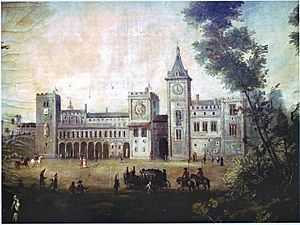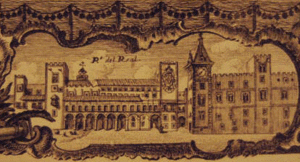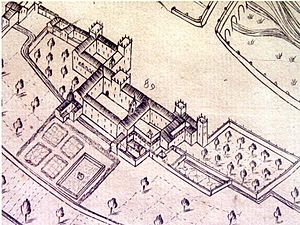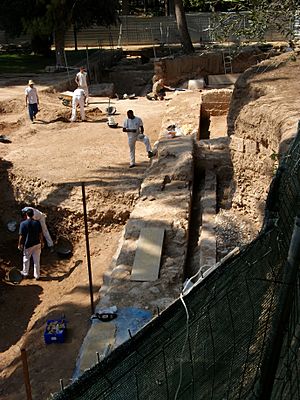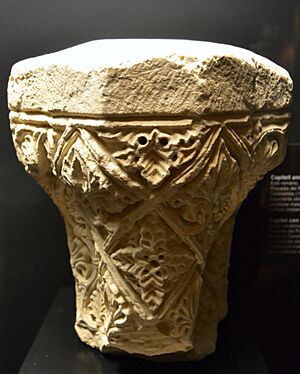Del Real Palace, Valencia facts for kids
The Del Real Palace, also known as the Royal Palace, was once a grand home for kings in the city of Valencia, Spain. In Valencian, it was called Palau del Real. It stood by the Turia River, where the Jardines del Real (Royal Gardens) are today. People sometimes called it the "300 keys palace" because it had so many rooms!
For over 800 years, from the 11th to the 19th century, this palace was a royal home. Kings from different families lived there, including those from the Taifa of Valencia, the Crown of Aragon, the Habsburgs, and the Bourbons. It was a very important building for the Kingdom of Valencia.
Palace Beginnings
The palace was first built in the 11th century by King Abd al-Aziz. It started as a special country house, or almúnia, outside the city. These types of homes were called real (from the Arabic word riyad, meaning garden). This is why the palace was named "Real Palace"—because it was a beautiful garden residence.
An Arab writer named Henri Péres described the palace as amazing. He said it had a large garden with fruit trees and flowers. A river flowed through it, and the palace itself was in the middle. Its rooms were beautifully decorated and opened up to the garden.
Sadly, in 1364, during a war with Castile, soldiers led by Peter the Cruel attacked the palace. They burned it down and took everything valuable.
Growing Bigger and Better
After the fire, Peter the Ceremonious almost completely rebuilt the palace. He made it the main home for the kings of Aragon. He also made the gardens much larger in the 14th century, planning for a truly grand palace.
Later kings, like John I and Alfonso the Magnanimous, also made it bigger. Alfonso spent a lot of money to make it one of the best royal palaces in the Crown of Aragon. His wife, Queen Maria, loved living there. She even governed the kingdoms from the palace when her husband was away. Records from that time show the palace was very fancy, with many tapestries, paintings, and rich furniture.
The palace had two main parts: the Real Vell (Old Real) and the Real Nou (New Real). The old Arab building had a central courtyard and four towers. The new part had two courtyards. The biggest rooms, where parties and important meetings happened, were on the first floor.
The gardens were amazing, too. They had ponds and special plants brought all the way from America. There was even a small zoo with lions, bears, deer, and colorful birds like peacocks. Some of these gardens are now part of the Viveros park in Valencia.
In the 16th and 17th centuries, the palace became the home for the viceroys of Valencia. These were like governors who ruled for the king. It also held important royal records. Later, in the 18th century, it was used by military leaders called captain generals. During this time, the palace was changed a lot. Its old Gothic windows were removed, and a new arched walkway was added to the front.
From Demolition to Today
In 1810, during the Peninsular War against Napoleon's troops, the people of Valencia made a difficult decision. They decided to tear down the palace. They wanted to stop the French army from using it as a strong base against the city. However, this didn't really help. The palace was destroyed due to a mix of bad military planning and the city's need for money. Some people also saw the old palace as a symbol of the past they wanted to change. Only a small piece of its decorated ceiling was saved.
For many years, the palace was gone. Then, in 1986, during some construction work, parts of the palace's remains were found under a street. There was a big debate about whether to dig them up or rebury them. They were reburied because the street was a very busy road.
In 2009, new tests were done, and more remains were found. This made people even more interested in the lost palace. Even though the Del Real Palace can't be rebuilt, archaeologists are still excited to learn more. They have found walls belonging to the "Queen's Tower," which was once the home of Queen Maria.
For a long time, the only visible sign of the palace was a small hill in the Jardines del Real. People say this hill is made of the rubble from the palace's destruction.
Today, we know exactly what the palace looked like. This is thanks to the discovery of its original plans, drawn in 1802. These plans were taken by French troops during the war and ended up in Paris. They were found by chance in 2004 by a professor named Josep Vicent Boira.
See also
 In Spanish: Palacio del Real de Valencia para niños
In Spanish: Palacio del Real de Valencia para niños


